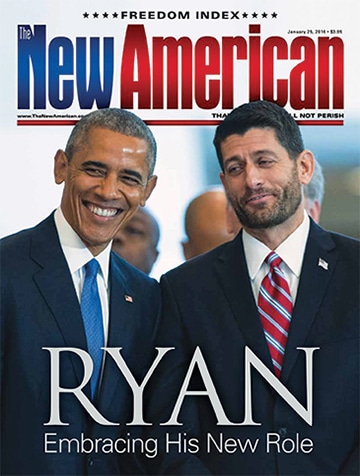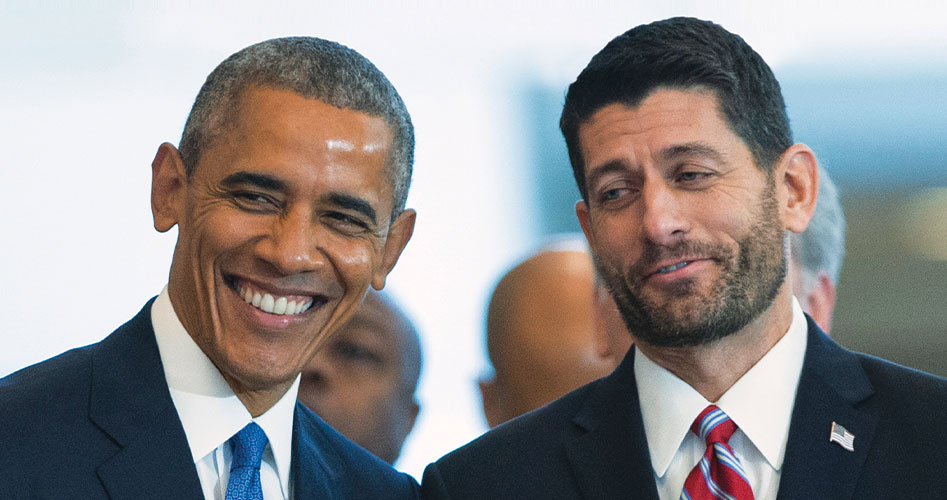Ryan Embracing His New Role
In the perennial holiday movie favorite The Santa Clause, Tim Allen’s character accidentally causes Santa Claus to fall off a snowy roof while delivering toys Christmas Eve. As a result of the “Santa clause,” a magical rule providing for a successor Santa, Allen literally turns into Saint Nick, in preparation for his new life’s calling. Among many other things, he inexplicably begins growing a beard — one that magically regrows moments after being shaved.
Those familiar with this particular entry in the holiday movie canon might have been alarmed when brand new Speaker of the House Paul Ryan began growing a beard immediately after his election in November to the most powerful position in Congress. Like Tim Allen’s character, Paul Ryan, initially reluctant to accept the speakership, soon embraced his new role and, as his first major act in that capacity, got Congress to pass a massive new $1.1 trillion omnibus appropriations bill that showered expensive goodies on nearly every special interest group in Washington, including the recently maligned Planned Parenthood and advocates of Syrian immigration. With the generosity of Santa Claus, Ryan made sure every big-spending Democrat in Washington had toys in their stockings, leading to effusions of glee from Democratic leaders and dismay from the authentic partisans of limited government inside the Beltway.
In short, the recent omnibus spending bill showed Paul Ryan for who he is — a younger, leaner version of his maligned, accommodationist, big-spending predecessor, John Boehner — rather than the champion of lower spending and limited government that many conservatives had desperately hoped he was.
Passed the week before Christmas on December 18, the bill was greeted with unrestrained triumphalism on the part of leading Democrats since, yet again, they had succeeded in cowing the Republican majority into accepting and funding most of their agenda. In the new spending package, Republicans “gave away the store,” chortled House Minority Leader Nancy Pelosi, adding, “I feel almost jubilant about what is in this appropriations bill.”
Referring to the thousands of pages in the bill and the mere two days allowed for congressional and public review — time-honored tactics designed to sneak controversial spending into law — Pelosi admitted that Democratic leaders were careful to keep aspects of the bill off the public and congressional radar. “We’ve had to sort of calibrate how we presented this [omnibus bill] to members because … we were afraid [Republicans] might pull things out if more Republicans knew about what was in the bill,” she said, according to an article in RollCall.com.
Other Democrats joined in Pelosi’s rhetorical victory lap. “This was an extraordinarily big victory,” exulted House Minority Whip (and former Majority Leader) Steny Hoyer, who described the epic Republican cave-in in glowing terms right after the vote. “What happened was, over [the last] 24 hours, members reflected on what they did get — the glass was about 80 percent or 90 percent full, not half empty. Yesterday it was half empty; today it was 90 percent full, and I think that resulted in the overwhelming vote that we saw.”
In the end, 166 out of 188 House Democrats joined 150 House Republicans in supporting the bill, while in the Senate, 38 Democrats (out of 45 total) supported the bill alongside a mere 27 (out of a total 54) Republicans. In other words, a bare majority of congressional Republicans (61 percent in the House and 50 percent in the Senate) supported the bill, as against an overwhelming majority of Democrats in both houses (88 percent in the House and 84 percent in the Senate, giving credence to Hoyer’s claim that the glass was “80 percent or 90 percent full”) — proving beyond any possible shadow of a doubt that this spending bill was designed primarily to appease Democrats and their big-government Republican allies inside the Beltway.
How does Ryan’s omnibus spending bill toady to Democrats and tax-and-spend Big Government devotees everywhere? Let us count the ways.
Spending Broken Down
In matters of the environment, Al Gore himself probably could have done no better. The bill extended tax credits for inefficient and costly — but politically correct — wind and solar power production. The EPA received enhanced regulatory jurisdiction under the Clean Water Act. Attempts to block new regulation of power plants were set aside. And perhaps most infuriatingly, the bill authorized continued contributions to the international Green Climate Fund (GCF) — a critical element of the new Paris climate agreement, negotiated mere days after the Paris terror attacks by world environmental elites, including President Obama, who regard environmental protection as a higher priority than defense against terrorism. Obama pledged $3 billion to the GCF — which is supposedly to help poorer countries prepare for climate change — by 2020, and asked for $500 million in 2016. The spending bill does not authorize spending for the GCF, but neither does it explicitly prohibit it, thereby allowing Obama to obtain the money from existing discretionary spending streams. Referring to this victory for climate-change extremists, Friends of the Earth analyst Karen Orenstein could not resist scolding “climate change deniers.” “This is a rebuke to those congressional extremists who tried to play politics with desperately needed money to help the world’s poor take climate action,” Orenstein said in an official statement. “Morality and reason, rather than science-denying isolationism, prevailed in this case.”
In the financial sector, the avalanche of new regulations promulgated during the Obama administration remained intact. An effort to reduce the number of financial institutions deemed “systemically important” (and thereby falling under the authority of enhanced regulatory scrutiny authorized by the Dodd-Frank bill of 2010) was set aside, and the Consumer Financial Protection Bureau (created by Dodd-Frank), which now regulates virtually every aspect of financial activity, from credit cards to mortgage firms to retirement funds, will continue to be immune from appropriations funding cuts.
With immigration — arguably the most important issue in most Americans’ minds at the moment — the bill ignores a wide range of voter concerns over illegal immigrants. For example, President Obama’s much-maligned Deferred Action for Childhood Arrivals (DACA) amnesty program for the children of illegal aliens in the United States was fully funded. Since 2012, Obama’s DACA executive action has resulted in around 700,000 work permits for illegal aliens, as well as access to federal tax credits and entitlement benefits. It is this program, of course, that has led to a dramatic surge in child illegal immigrants (or “unaccompanied child migrants,” in the nuanced language of federal bureaucrats) between 2012 (28,000) and 2014 (73,000). Ryan’s omnibus bill, by containing no language explicitly defunding DACA, has allowed it (and the rest of Obama’s executive amnesty power grab) to continue.
The bill also made no mention of “sanctuary cities” such as San Francisco that have defied federal laws in refusing to deport illegal aliens. Again, by including no language prohibiting grants to “sanctuary cities,” Ryan’s bill has in effect allowed the practice of harboring illegal aliens — including hardened criminals, such as the five-times-convicted criminal alien who murdered Kate Steimle a few months ago, who was a beneficiary of San Francisco’s sanctuary policies — to continue unabated.
In the weeks leading up to passage of the bill, Representative Brian Babin (R-Texas) introduced a proposal to halt all refugee resettlement, a proposal that had 84 cosponsors in the House. Like their constituents, many Republicans in Congress were concerned at the potential for ISIS terrorists to slip into the country among refugees of the Syrian conflict — refugees for whom vetting for the purposes of security is impossible because of the lack of functioning government record-keeping in war-torn Syria. Yet the finished bill contained no language restricting the influx of refugees from the war-torn Middle East — this, one supposes, because Ryan does not believe in halting or even stemming the flow of refugees because, as he told Fox News’ Sean Hannity recently, “We’re a compassionate country.”
The bill also quadruples the number of controversial H-2B “guest worker” visas, and does not contemplate any restrictions or increased oversight of the issuance of F-1 student visas and K-1 “fiancée” visas to residents of countries with strong jihadist movements, despite the fact that jihadists have exploited these visas to get into the country. Child tax credits for illegal aliens were also preserved.
All of these were GOP “talking points” in the months leading up to passage of the spending bill, in response to widespread concern over illegal immigration and the potential — highlighted by the San Bernardino terrorist mass shooting — that radicalized Muslims bent on committing acts of terrorism could exploit lax immigration monitoring or use the chaos of the Syrian refugee crisis as cover to get into the United States. Yet the omnibus spending bill completely ignored such concerns.
Another high-profile talking point — and, we were led to believe, bona fide GOP agenda item — was the defunding of Planned Parenthood after a series of taped interviews with Planned Parenthood officials revealed that the abortion provider traffics in the body parts of aborted fetuses. But it seems that no amount of moral depravity, however thoroughly documented, will be enough to persuade the People Who Matter on Capitol Hill, Republicans and Democrats alike, to stop the flow of federal monies that support the world’s premier practitioner of infanticide. After months of outrage, testimony, and damning evidence, the response of the Ryan-sponsored spending bill was to ignore the Planned Parenthood issue.
Overall, the bill locked in the huge spending increases, and the abandonment of all spending caps, that were formalized last year by John Boehner. Now, official Washington is unwilling to countenance the mere appearance of fiscal restraint, as emblemized by the sequesters and spending caps Democrats fought so acrimoniously to overthrow. In fact, defense and non-defense spending are slated to increase next year by $25 billion apiece.
Thus Ryan’s bill is an act of open defiance of the people’s will on immigration, Planned Parenthood, manufactured climate-change hysteria, and overall out-of-control government spending — an exclamation mark signaling the continued liberal establishment control of both political parties.
Where Goes the GOP?
How has it come about that, despite a clear two-decade trend toward electing more and more truly conservative and even constitutionalist GOP representatives, legislation emanating from the GOP leadership is as defiantly accommodating of the priorities of tax-and-spend liberals as it ever was? Long gone are the days when Ron Paul (now retired) was the lone voice of fiscal and constitutional sanity in both houses of Congress; today there are perhaps a half-dozen in the House with views that approximate those of Ron Paul in terms of fidelity to the Constitution and belief in laissez-faire free market economics, and a much larger number of representatives often willing to follow their lead. In the Senate, meanwhile, an impressive number of GOP senators have shown themselves to be reliable partisans of liberty and limited government (no less than five GOP senators have a cumulative voting score of 90 percent or higher on The New American’s Freedom Index, with a sixth — Ted Cruz — falling just short at 89 percent). Yet the Thomas Massies of the House and the Rand Pauls of the Senate find themselves perennially marginalized, shut out of influential leadership posts (much as Ron Paul once was) no matter how much seniority or support among their colleagues they manage to accumulate. And it is in the critical leadership positions, as Paul Ryan has demonstrated yet again, where the true power rests, even in “the people’s House.” This is because it is the leaders — the speaker, majority leader, and chairs of the various House committees — who have the authority to determine which bills and proposals actually see the light of day. A similar authority structure exists in the Senate. It is thus nearly irrelevant what the majority of representatives, senators, or their constituents may want; it is the gatekeepers who chair the committees, and the other appointed leaders in each body, who determine which legislative initiatives see the light of day.
As the recent tumult in the House leading to the surprise resignation of John Boehner as speaker and the rise of Paul Ryan as his replacement illustrates, the elites in the GOP establishment still control who sits in the positions that matter. As The New American(and many other media) documented, Paul Ryan was and is ideologically indistinguishable from his predecessor. Many in the House, especially the members of the large Liberty Caucus, were well aware of this and opposed his speakership. But in the end, it made no difference. Thanks to a well-choreographed media campaign on his behalf, the coronation of Paul Ryan was portrayed as inevitable, with Ryan allegedly the only man who could possibly unite the fractious GOP House delegation and rein in “right-wing extremists” who insisted on honoring their promises to their constituents and their oaths to the Constitution. In the face of such pressure, a sufficient number of GOP representatives were willing to support a Ryan speakership. And as we have now witnessed, nothing has changed from the bad old days of John Boehner (except Ryan’s facial hair).
The Boehners and Ryans of the world are forever defending their actions in the name of “compromise.” Yet if the GOP were truly the party of limited government, less spending, and lower taxes, as it so often claims, then we would at least occasionally see “compromise” consist of the GOP proposing significant, very deep, across-the-board spending cuts that would significantly decrease both the size and cost of government, with the Democrats insisting on the usual spending increases, and the final result involving deep cuts in spending, but not quite as deep as Republicans hoped for. If Republicans were truly the party of free enterprise, we would see substantial and immediate rollbacks of a large part of the illegitimate regulatory government-within-a-government that has restricted growth since the era of the New Deal; because of the need for “compromise,” some of those cuts would need to be phased in gradually, but a clear trend toward less regulation of private enterprise would be evident. And if the GOP were truly the party of life, implacably opposed to abortion on demand, Planned Parenthood would have been defunded long ago.
But we see none of these things. Instead of cuts in government spending, we see occasional pauses in the rate of increase of spending, which are dishonestly passed off as “cuts.” Despite their professed hostility to Big Government, we see the GOP strangely reluctant to actually shut that government down whenever Democrats demand more and more borrowing and spending and their media shills start calling Republicans nasty names. Instead of concerted efforts to come to grips with the problem of illegal immigration, the GOP presents the unlovely spectacle of a house divided, with many Republicans — such as Paul Ryan — apparently in favor of unrestricted immigration, no matter what the sociopolitical costs. And instead of principled opposition to the paladins of cultural Marxism — whose agenda priorities include ensuring abortion on demand in perpetuum and the legalization and mainstreaming of every species of alternative lifestyle, including, but certainly not limited to, so-called same-sex marriage — we see spineless Republicans throw in the towel again and again, allowing an immoral minority to dictate terms to everybody else.
The difference between Democrats and the “moderate” Republicans who enable them is that the former have the courage of their convictions, which they promote with “passionate intensity,” while the latter, in the words of the poet, “lack all conviction.” Democrats all agree, in varying degrees, with the premise of socialism, that all human problems can be solved by the creative application of government power. This they use as their rallying standard. Republicans, by contrast, have no unifying standard, with a valiant few rallying around the Constitution and the free market, and the rest showing varying degrees of fealty to Big Government — but not as much as the hated Democrats, or so they would have us believe.
The Ryan omnibus budget bill is a stern lesson to ordinary Americans as to whose priorities actually hold sway in Washington — priorities that Paul Ryan is unlikely to deviate from. As long as he, or one such as he, holds the speakership, the unrestrained growth of government will continue. Because so much power in Congress rests disproportionately on the leadership, none of this will change until enough genuine constitutionalists are elected to actually affect who can and cannot be appointed to those leadership positions. In the case of the House, we have made progress, but we are a far cry from the point where a Justin Amash or Thomas Massie will be anything but marginalized. For genuine reform, dozens of additional genuine constitutionalists will need to be elected.
For that to happen, the electorate will need to be much more informed than it is right now. Until that occurs, the Paul Ryans of the world will continue to get away with flouting the Constitution and the will of the people who elected them.



